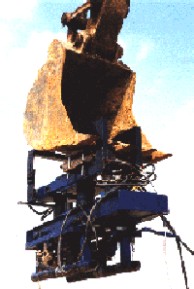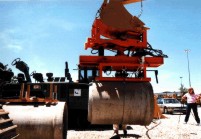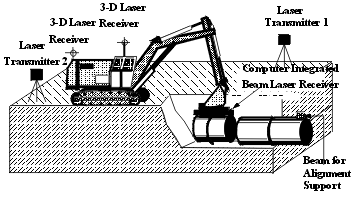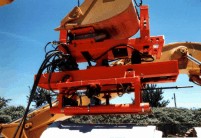 |
Pipeman:Safety
in Trenches
The Need
|
Even though
heavy construction equipment such as a crane or backhoe
excavator, is used to perform the task of pipe laying in the
trench, workers are required to be inside the trench to
guide the excavation, pipe laying, and final alignment. Work
place safety has become a major concern in the construction
industry over the past few decades, and trench cave-ins have
caused serious and often fatal injuries to workers in the
United States. It has become of crucial importance to
implement the use of new technologies to prevent
accidents in trench excavation and pipe installation.
Diverse approaches such
as shoring, shielding, and sloping have been applied to
protect workers from cave-ins in trenching and pipe laying
operations. However, even when support systems are used, the
danger of cave-ins still exists due to the nature of the
soil and unexpected circumstances.
The Construction
Automation and Robotics Laboratory(CARL) at North Carolina
State University has developed an alternative which involves
advanced new technology: the prototype robotic excavation
and pipe installation system.
|

Pipe manipulator mounted on the excavator

Overview of Pipe manipulator
|
The Technology
The
basic concept consists of a 3-D spatial positioning
system(SPS), which is interfaced with an excavator to
provide the location of the excavator and a beam laser. A
pipe manipulator prototype is attached to the bucket of the
excavator, which is capable of handling pipes of various
sizes. A beam laser is also used to help the operator align
pipes. Integration of SPS with a CAD system will update the
excavator position in real-time and provide an as-built
drawing of pipe laying. 
Layout of the robotic trenching and pipe installation
system(Huang & Bernold, 1993)
The main components of the
concept are the man-machine interface, actuation system,
laser beam and feedback system.The man-machine interface is
used to keep the operator in a safe area and allow him to
guide the Pipeman intelligently, while the Pipeman
works in a hazardous environment. The man-machine interface
also in includes manipulation and visualization functions.
The operator will have two different joysticks to control 1)
the excavator, and 2) the pipe manipulator prototype. The
operator will see his/her manipulation status through
visualization functions.
- H.Motor(M_Rot1): A
hydraulic motor provides +/- 100 degrees rotation of
the pipe in order to line up the pipe.
- H.Motor(M_Rot2): A
hydraulic motor provides a locking mechanism on the
back of the pipe manipulator prototype to prevent
the pipe manipulator from sliding from the bucket.
- H.Cylinder(C_Trans): A
hydraulic cylinder provides a linear activation of
the pipe to joint the new pipe to the pipe already
laid.
- H.Bladders(B_Clamp):
Hydraulic bladders provide inflating and deflating
mechanisms to clamp the pipe manipulator to the
bucket
- E.Winch(W-Hold): An
electric winch is used to attach the pipe with a
quick release.

Schematic
overview of the Pipeman
The amount of clearance
available to insert the bucket is 10.5 inches(26.7 cm)in
order to fit the bucket more easily. Bladders(B_Clamp) have
been mounted to support the bucket and to prevent it from
slipping off in operation. The basic principle of the
bladder system is to introduce the hydraulic fluid into the
unit trough the bladder intake, causing the bladders to
inflate, which clamps the pipe manipulator to the bucket. To
eliminate slippage, a rubber plate of 1 inch(2.54 cm) of
thickness is also attached both at the bottom of the upper
part of the cantilever hook and on the top of the steel
plate over the bladders. Additionally, to prevent the pipe
manipulator from sliding off the bucket, a locking mechanism
on the back of the pipe manipulator has been designed as a
mechanical stop. A rotational motor (M-Rot2) will rotate
steel bars(backstop) toward the back of the bucket.
A simple joystick and on/off
switches are applied for easy manual control and the
electro-hydraulic valves are used to activate each actuation
function. The beam laser system is also used to align the
pipes. Two laser targets are used to make sure that the
grade is correct. Micro cameras as feedback system are
mounted to improve the machine interface. This system allows
the operator to have a real-time visual control for the
final alignment of the pipe joint.
|
The Benefits
- The greatest advantage
of the Pipeman is that it offers a new technological
approach to pipe installation which has the
potential of improving safety.
- One key item in every
project is the cost associated with
OSHA(Occupational Safety and Health Administration)
to protect workers in an open trench. By removing
the need for workers going into the trench, the OSHA
regulations do not have to be followed, therefore a
major cost factor is eliminated.
- Also, this technology
will drastically reduce the number of fatal
accidents and lost workdays due to injuries, because
the robotic manipulator will reduce or eliminate the
exposure of humans to risks such as collapsing
trenches, and cave-ins.
- Preliminary evaluations
of the economic benefits shows excellent results and
monetary savings using conservative assumptions. The
evaluation does not include reduction in insurance
premiums and possible increases in productivity.
Therefore, it is possible to reduce costs and
improve safety by implementing this technology.
|
Status
|
The prototype
robotic excavation and pipe installation system has
been developed by the Construction Automation and Robotics
Laboratory(CARL) at North Carolina State University. It is
sponsored by the National Institute for Occupational Safety
and Health(NIOSH).
Work is
continuing on testing the system with different soils and
depths. An economic evaluation of the performance will also
be performed with statically sound data analysis.
|

Preliminary evaluation of
economic benefits shows excellent results using
the Pipe manipulator
|
Points of Contact
- Dr. Leonhard
Bernold. Director, Construction Automation and
Robotics Laboratory(CARL) at North Carolina State University, Dept. of
Civil Engineering, Raleigh NC. Phone: (919)515-3677 Fax: (919)515-7908, Email:
bernold@eos.ncsu.edu
- Dr. Steven J. Lorenc. Associate Director
of Technology Development Assistant Research Professor North
Carolina State University, Dept. of Civil Engineering, Raleigh NC.
Phone: (919)515-8408 Fax: (919)515-7908,
Email: sjlorenc@eos.ncsu.edu
References
- Lee Junbok, Lorenc Steven,
Bernold Leonhard. Saving Lives and Money with Robotic Trenching and Pipe
Installation. Construction Automation
and Robotics Laboratory(CARL) at North Carolina State University. http://www2.ncsu.edu/ncsu/CIL/CARL/research/robpipe/pipeman.pdf
- PIPEMAN: Safety in trenches.
ConExpo March 23-27
- Tele-Robotic
Excavation/Remote Pipe-Laying: http://www2.ncsu.edu/ncsu/CIL/CARL/research/robpipe/wwww_trerpl.html
- Bernold Leonhard, Huang
Xiaodong. CAD-Integrated Real-Time Control for Robotic Excavation and
Pipe Laying:Development and Testing. North
Carolina State University, Dept. of Civil Engineering, Raleigh NC.
August 1997 http://www.azfms.com/DocReviews/Nov97/art15.htm
Disclaimer Statement
Neither
the Construction Safety Alliance nor Purdue University in
any way endorses this technology or represents that the
information presented can be relied upon without further
investigation. |
|


